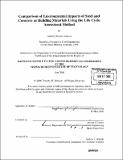| dc.contributor.advisor | Jerome J. Connor. | en_US |
| dc.contributor.author | Johnson, Timothy Werner | en_US |
| dc.contributor.other | Massachusetts Institute of Technology. Dept. of Civil and Environmental Engineering. | en_US |
| dc.date.accessioned | 2006-11-07T13:34:20Z | |
| dc.date.available | 2006-11-07T13:34:20Z | |
| dc.date.copyright | 2006 | en_US |
| dc.date.issued | 2006 | en_US |
| dc.identifier.uri | http://hdl.handle.net/1721.1/34608 | |
| dc.description | Thesis (S.M.)--Massachusetts Institute of Technology, Dept. of Civil and Environmental Engineering, 2006. | en_US |
| dc.description | Includes bibliographical references (p. 115-119). | en_US |
| dc.description.abstract | In the United States, the construction industry accounts for almost 75% of total raw material used. This is an obvious drain on natural resources and has a major impact on the surrounding environment. Construction materials are also responsible for a relatively large portion of the global CO2 emissions. The commercial construction industry is dominated by the use of steel and in-situ concrete as building materials. It is intuitive then, to state that these two materials and their respective production flows have a significant impact on the environment, simply because of the amount of material being produced and consumed in the building industry today. In addition, due to drastic increases in energy prices and potential shortages in the future, the amount of energy consumed in the production of construction materials (embodied energy) and the amount of energy used over a projected life span (operational energy) are becoming increasingly more important to builders, designers, and owners of buildings. The growing trend in the United States, and elsewhere in the world, is towards eco-friendly design. In the last several years, the concrete and steel industries have spent significant resources to promote their material as the optimum solution for sustainable building design. | en_US |
| dc.description.abstract | (cont.) Because natural resource consumption, air emissions, and the amount of embodied energy are all important drivers for the push towards sustainability, this study will compare those factors and quantify the differences between what is necessary for the construction of concrete- and steel-frame structures. The purpose of this thesis is to utilize the Life Cycle Assessment (LCA) method to compare the environmental impacts created by the steel and concrete construction industry at the lowest common performance level, in this case the structural shell of a typical building in a given geographical area. The study will include all major product systems and material flows involved with concrete or steel construction and quantify their impacts in terms of total energy requirement, natural resources consumed, and harmful air emissions, specifically as they relate to global warming potential. | en_US |
| dc.description.statementofresponsibility | by Timothy Werner Johnson. | en_US |
| dc.format.extent | 155 p. | en_US |
| dc.format.extent | 8760970 bytes | |
| dc.format.extent | 8767492 bytes | |
| dc.format.mimetype | application/pdf | |
| dc.format.mimetype | application/pdf | |
| dc.language.iso | eng | en_US |
| dc.publisher | Massachusetts Institute of Technology | en_US |
| dc.rights | M.I.T. theses are protected by copyright. They may be viewed from this source for any purpose, but reproduction or distribution in any format is prohibited without written permission. See provided URL for inquiries about permission. | en_US |
| dc.rights.uri | http://dspace.mit.edu/handle/1721.1/7582 | |
| dc.subject | Civil and Environmental Engineering. | en_US |
| dc.title | Comparison of environmental impacts of steel and concrete as building materials using the Life Cycle Assessment method | en_US |
| dc.type | Thesis | en_US |
| dc.description.degree | S.M. | en_US |
| dc.contributor.department | Massachusetts Institute of Technology. Department of Civil and Environmental Engineering | |
| dc.identifier.oclc | 71301837 | en_US |
